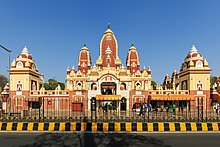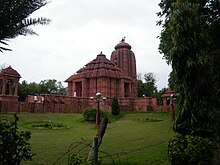The Birla family is a family connected with the industrial and social history of India.

The Marwari or Marwadi are an Indian ethnic group that originate from the Marwar region of Rajasthan, India. Their language, also called Marwari, comes under the umbrella of Rajasthani languages, which is part of the Western Zone of Indo-Aryan languages.
Nagda is an industrial town in Ujjain district of the Indian state of Madhya Pradesh. It lies in the administrative headquarters of the city of Ujjain, in the Malwa region of western Madhya Pradesh. It is situated on the bank of the Chambal River.
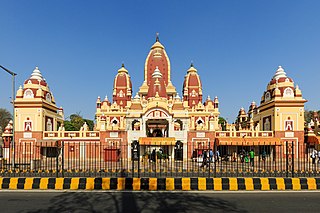
The Laxminarayan Mandir is a Hindu temple located in Delhi, India. The presiding deity in the temple is Laxminarayan i.e., Vishnu along with his consort Lakshmi. The temple was inaugurated by Mahatma Gandhi. Gandhi ensured that members of all castes would be allowed in the temple. It was built by Jugal Kishore Birla from 1933 and 1939. There are also small shrines on the sides dedicated to Shiva, Ganesha, Hanuman and Buddha.

The Gwalior Fort, commonly known as the Gwāliiyar Qila, is a hill fort near Gwalior, Madhya Pradesh, India. The fort has existed at least since the 10th century, and the inscriptions and monuments found within what is now the fort campus indicate that it may have existed as early as the beginning of the 6th century. The modern-day fort, embodying a defensive structure and two palaces was built by the Tomar Rajput ruler Man Singh Tomar. The fort has been administered by a number of different rulers in its history.

Ambika Mata Mandir is a Hindu temple located in the village of Jagat, about 50 km southeast of Udaipur in the state of Rajasthan, India. Ambika Devi, a form of Goddess Durga is the presiding deity of the temple. It was built under the reign of Rawal Allata of Mewar. The temple, located in a cleft of rock possesses a number of inscriptions. The earliest one, dated 961 AD, refers to a repair made to it. Today, the temple is preserved by the State Department of Archaeology and Museum, Rajasthan.

A Jain temple, Derasar or Basadi is the place of worship for Jains, the followers of Jainism. Jain architecture is essentially restricted to temples and monasteries, and Jain buildings generally reflect the prevailing style of the place and time they were built.
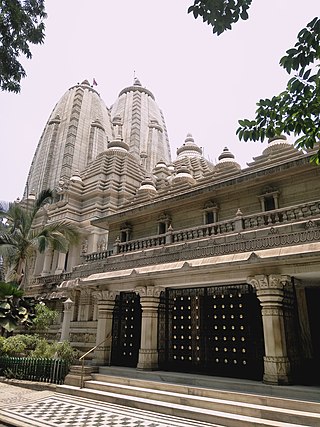
Birla Mandir in Kolkata, India, is a Hindu temple on Asutosh Chowdhury Avenue, Ballygunge, built by the industrialist Birla family. It is dedicated to Vishnu avatars such as Rama and Krishna. This temple is open in the morning from 5.30 A.M. to 11 A.M. and in the evening from 4 .30 P.M. to 9 P.M. On Janmashtami, the birthday of Krishna, devotees come from far away places to pay their respect to the deities.

Birla Mandir, Jaipur is a Hindu temple located in Jaipur, India and is one of many Birla mandirs. It was built by the B.M. Birla Foundation in 1988 and is constructed solely of white marble. It is dedicated to the Hindu goddess and Lakshmi and god Vishnu (Narayan), whose images appear inside, along with other Hindu gods and goddesses and selections from the Gita and Upanishads. It is located in Jaipur's Tilak Nagar neighborhood near Moti Dungari hill.

Hutheesing Temple is a Jain temple in Ahmedabad in Gujarat, India. It was constructed in 1848 by the Hutheesing family. The temple blends the old Maru-Gurjara temple architecture style with new architectural elements of haveli in its design.
Sheth Jugal Kishore Birla was a scion of the Birla family and the eldest son of Baldeo Das Birla. He was a noted industrialist, philanthropist and vocal supporter of Hindu philosophy.
Rani Sati, also identified as Narayani Devi and referred to as Dadiji (grandmother), is said to be a Rajasthani woman who lived sometime between the 13th and the 17th century and committed sati (self-immolation) on her husband's death. Various temples in Rajasthan and elsewhere are devoted to her worship and to commemorate her act.
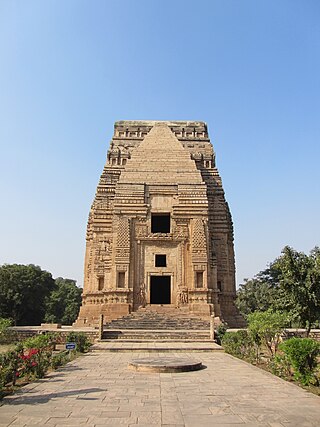
Teli ka Mandir, also known as Telika Temple, is a Hindu temple located within the Gwalior Fort in Madhya Pradesh, India. Dedicated to Shiva, Vishnu and Matrikas, it has been variously dated between the early 8th and early 9th century CE.

Shri Vishwanath Mandir also known as Vishwanath Mandir, Vishwanath Temple, New Vishwanath Temple and Birla Temple is another prominent Hindu temple in the holy city of Varanasi. Hindus across India and abroad visit this particular Lord Shiva temple to offer prayer to the Lord Vishwanath for the well-being of their families, and eternal peace. Every Hindu must perform a specific ritualistic homage for the departed souls of their ancestors this requires them to undertake pilgrimage to the holy city of Varanasi. The temple is situated near the Banaras Hindu University. Therefore, the temple site and the neighbourhood is a major attraction among Hindu students and visitors touring Varanasi. Shri Vishwanath Mandir has the tallest temple tower in the world with the Shikhara's height being around 250 feet. The temple is colloquially called VT, an acronym of Vishwanath Temple. The temple is under direct administration of the BHU.
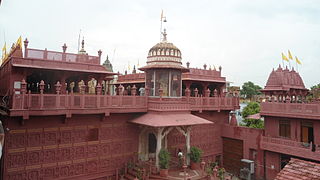
Shri Digamber Jain Atishya Kshetra Mandir, Sanghiji is an ancient Jain Temple in Sanganer, Rajasthan made of red stone. The ancient Shri Digamber Jain temple of Sanganer is 16 km from Jaipur.

Māru-Gurjara architecture or Solaṅkī style, is the style of West Indian temple architecture that originated in Gujarat and Rajasthan from the 11th to 13th centuries, under the Chaulukya dynasty. Although originating as a regional style in Hindu temple architecture, it became especially popular in Jain temples, and mainly under Jain patronage later spread across India, then later to diaspora communities around the world.
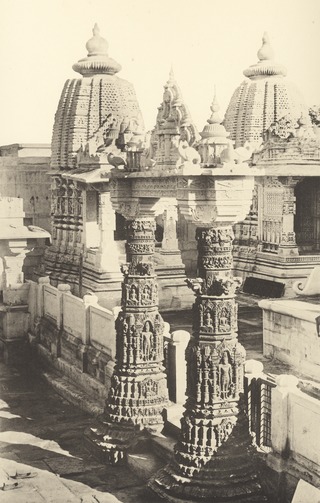
The Mahavira Jain temple is built in Osian of Jodhpur District, Rajasthan. The temple is an important pilgrimage of the Oswal Jain community. This temple is the oldest surviving Jain temple in Western India and was built during the reign of Mahārāja Śrī Vatsarāja of Imperial Pratihāras. The temple is visited by both Jain and Hindu.
The Architecture of Gujarat consists of architecture in the Indian state of Gujarat.
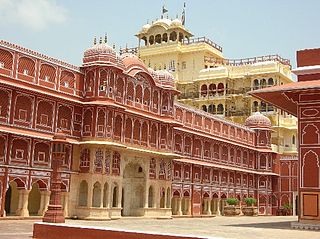
Rajput architecture is an architectural style notable for the forts and palaces of the many Rajput rulers, which are popular tourist attractions, many of the Rajput forts are UNESCO World Heritage Site.
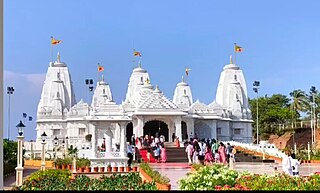
Birla Radha Krishna Mandir is a Hindu temple in Goa.
